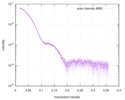[English] 日本語
 Yorodumi
Yorodumi- SASDDW5: 4-hydroxy-tetrahydrodipicolinate synthase (DHDPS-apo) from C. bot... -
+ Open data
Open data
- Basic information
Basic information
| Entry |  |
|---|---|
 Sample Sample | 4-hydroxy-tetrahydrodipicolinate synthase (DHDPS-apo) from C. botulinum + pyruvate
|
| Function / homology |  Function and homology information Function and homology information4-hydroxy-tetrahydrodipicolinate synthase / 4-hydroxy-tetrahydrodipicolinate synthase activity / diaminopimelate biosynthetic process / lysine biosynthetic process via diaminopimelate / cytosol Similarity search - Function |
| Biological species |  Clostridium botulinum (strain Hall / ATCC 3502 / NCTC 13319 / Type A) (bacteria) Clostridium botulinum (strain Hall / ATCC 3502 / NCTC 13319 / Type A) (bacteria) |
 Citation Citation |  Date: 2018 May Date: 2018 MayTitle: Substrate Locking Promotes Dimer-Dimer Docking of an Enzyme Antibiotic Target Authors: Atkinson S / Dogovski C / Wood K / Griffin M / Gorman M / Hor L / Reboul C / Buckle A / Wuttke J / Parker M / Dobson R |
 Contact author Contact author |
|
- Structure visualization
Structure visualization
- Downloads & links
Downloads & links
-Data source
| SASBDB page |  SASDDW5 SASDDW5 |
|---|
-Related structure data
| Related structure data | C: citing same article ( |
|---|---|
| Similar structure data | Similarity search - Function & homology  F&H Search F&H Search |
-Models
- Sample
Sample
 Sample Sample | Name: 4-hydroxy-tetrahydrodipicolinate synthase (DHDPS-apo) from C. botulinum + pyruvate Specimen concentration: 9.5 mg/ml |
|---|---|
| Buffer | Name: 20mM Tris, 150mM NaCl, 5mM sodium pyruvate / pH: 8 |
| Entity #1034 | Name: Cbot-DHDPS / Type: protein Description: 4-hydroxy-tetrahydrodipicolinate synthase from Clostridium botulinum Formula weight: 31.519 / Num. of mol.: 4 Source: Clostridium botulinum (strain Hall / ATCC 3502 / NCTC 13319 / Type A) References: UniProt: A5I6N2 Sequence: SIFKGSGVAI ITPFTNTGVD FDKLSELIEW HIKSKTDAII VCGTTGEATT MTETERKETI KFVIDKVNKR IPVIAGTGSN NTAASIAMSK WAESIGVDGL LVITPYYNKT TQKGLVKHFK AVSDAVSTPI IIYNVPGRTG LNITPGTLKE LCEDKNIVAV KEASGNISQI ...Sequence: SIFKGSGVAI ITPFTNTGVD FDKLSELIEW HIKSKTDAII VCGTTGEATT MTETERKETI KFVIDKVNKR IPVIAGTGSN NTAASIAMSK WAESIGVDGL LVITPYYNKT TQKGLVKHFK AVSDAVSTPI IIYNVPGRTG LNITPGTLKE LCEDKNIVAV KEASGNISQI AQIKALCGDK LDIYSGNDDQ IIPILALGGI GVISVLANVI PEDVHNMCEL YLNGKVNEAL KIQLDSLALT NALFIETNPI PVKTAMNLMN MKVGDLRLPL CEMNENNLEI LKKELKAYNL M |
-Experimental information
| Beam | Instrument name: Australian Synchrotron SAXS/WAXS / City: Melbourne / 国: Australia  / Shape: Point / Type of source: X-ray synchrotron / Wavelength: 0.10322 Å / Dist. spec. to detc.: 0.9 mm / Shape: Point / Type of source: X-ray synchrotron / Wavelength: 0.10322 Å / Dist. spec. to detc.: 0.9 mm | ||||||||||||||||||||||||||||||
|---|---|---|---|---|---|---|---|---|---|---|---|---|---|---|---|---|---|---|---|---|---|---|---|---|---|---|---|---|---|---|---|
| Detector | Name: Pilatus 1M | ||||||||||||||||||||||||||||||
| Scan | Measurement date: Nov 26, 2010 / Storage temperature: 4 °C / Cell temperature: 25 °C / Exposure time: 5 sec. / Number of frames: 8 / Unit: 1/A /
| ||||||||||||||||||||||||||||||
| Distance distribution function P(R) |
| ||||||||||||||||||||||||||||||
| Result |
|
 Movie
Movie Controller
Controller



